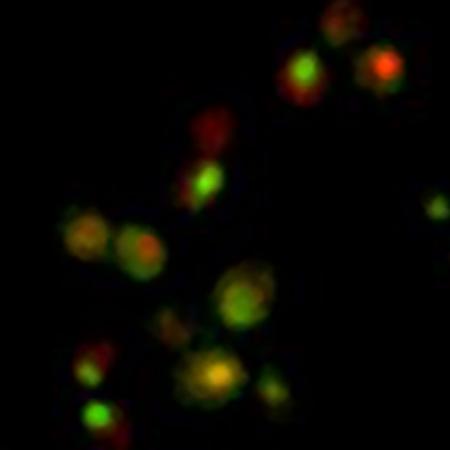Cells Rhythmically Regulate Their Genes

Complete the form below to unlock access to ALL audio articles.
Even in a calm, unchanging environment, cells are not static. Among other actions, cells activate and then deactivate some types of transcription factors—proteins that control the expression of genes—in a series of unpredictable and intermittent pulses. Since discovering this pulsing phenomenon, scientists have wondered what functions it could provide for cells.
Now, a new study from Caltech researchers shows that pulsing can allow two proteins to interact with each other in a rhythmic fashion that allows them to control genes. Specifically, when the expression of the transcription factors goes in and out of sync, gene expression also goes up and down. These rhythms of activation, the researchers say, may also underlie core processes in the cells of organisms from across the kingdoms of life.
"The way transcription factor pulses sync up with one another in time could play an important role in allowing cells to process information, communicate with other cells, and respond to stress," says paper coauthor Michael Elowitz, a professor of biology and biological engineering and an investigator with the Howard Hughes Medical Institute.

The research was led by Caltech postdoctoral scholar Yihan Lin. Other Caltech authors of the paper are Assistant Professor of Chemistry Long Cai; Chang Ho Sohn, a staff scientist in the Cai lab; and Elowitz's former graduate student Chiraj K. Dalal (PhD '10), now at UC San Francisco.
Cai, Dalal, and Elowitz reported a functional role for transcription factor pulsing in 2008. In the meantime, researchers worldwide have been steadily uncovering similar surges of protein activity across diverse cell types and genetic systems.
Realizing that many different factors are pulsing in the same cell even in unchanging conditions, the Caltech scientists began to wonder if cells might adjust the relative timing of these pulses to enable a novel sort of time-based regulation. To find out, they set up time-lapse movies to follow two pulsing proteins and a target gene in real time in individual yeast cells.
The team tagged two central transcription factors named Msn2 and Mig1 with green and red fluorescent proteins, respectively. When the transcription factors are activated, they move into the nucleus, where they influence gene expression. This movement—as well as the activation of the factors—can be visualized because the fluorescent markers concentrate within the small volume of the nucleus, causing it to glow brightly, either green, red, or both. The color choice for the fluorescent tags was symbolic: Msn2 serves as an activator, and Mig1 as a repressor. "Msn2, the green factor, steps on the gas and turns up gene expression, while Mig1, the red factor, hits the brakes," says Elowitz.
When the scientists stressed the yeast cells by adding heat, for example, or restricting food, the pulses of Msn2 and Mig1 changed their timing with respect to one another, with more or less frequent periods of overlap between their pulses, depending upon the stressing stimulus.
Generally, when the two transcription factors pulsed in synchrony, the repressor blocked the ability of the activator to turn on genes. "It's like someone simultaneously pumping the gas and brake pedals in a car over and over again," says Elowitz.
But when they were off-beat, with the activator pulsing without the repressor, gene expression increased. "When the cell alternates between the brake and the gas—the Msn2 transcription factor in this case—the car can move," says Elowitz. As a result of these stress-altered rhythms, the cells successfully produced more (or fewer) copies of certain proteins that helped the yeast cope with the unpleasant situation.
Previously, researchers have thought that the relative concentrations of multiple transcription factors in the nucleus determine how they regulate a common gene target—a phenomenon known as combinatorial regulation. But the new study suggests that the relative timing of the pulses of transcription factors may be just as important as their concentration.
"Most genes in the cell are regulated by several transcription factors in a combinatorial fashion, as parts of a complex network," says Cai. "What we're now seeing is a new mode of regulation that controls the pulse timing of transcription factors, and this could be critical to understanding the combinatorial regulation in genetic networks."
"There appears to be a layer of time-based regulation in the cell that, because it can only be observed with movies of individual cells, is still largely unexplored," says Lin. "We look forward to learning more about this intriguing and underappreciated form of gene regulation."
In future research, the scientists will try to understand how prevalent this newfound mode of time-based regulation is in a variety of cell types and will examine its involvement in gene regulation systems. In the context of synthetic biology—the harnessing and modification of biological systems for human technological applications—the researchers also hope to develop methods to control such pulsing to program new cellular behaviors.

